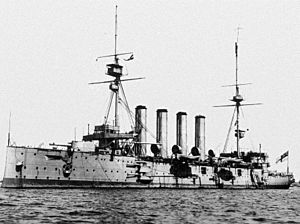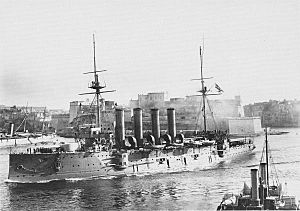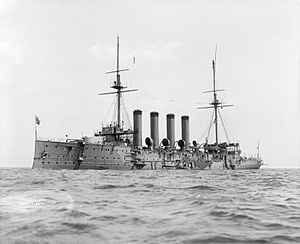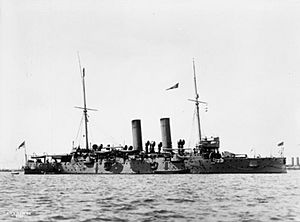7th Cruiser Squadron facts for kids
Quick facts for kids 7th Cruiser Squadron |
|
|---|---|
 |
|
| Active | 1912–1914 |
| Country | United Kingdom |
| Allegiance | British Empire |
| Branch | Royal Navy |
| Size | 5 ships |
| Engagements | Action of 22 September 1914 Battle of Cape Passero (1940) |
| Commanders | |
| Notable commanders |
Rear-Admiral Arthur Christian |
The 7th Cruiser Squadron (also known as Cruiser Force C) was a group of ships in the Royal Navy during the First World War. Their main job was to help block the English Channel to stop German ships. They patrolled an area of the North Sea called the Broad Fourteens. This helped protect the northern entrance to the Channel.
This squadron became very well known on 22 September 1914. On that day, a single German submarine sank three of their cruisers. About 1,460 sailors died in this event. People were very upset about the losses. This incident made some people lose trust in the government. It also hurt the Royal Navy's reputation. This was at a time when many countries were deciding which side to join in the war.
Contents
How the Squadron Started
The 7th Cruiser Squadron was created on 1 May 1912. It was part of a big change in how the Royal Navy organized its ships. This squadron was a reserve force. This means it was not always ready for battle. It was stationed on the south coast of England.
The squadron mostly had five large ships called Cressy-class armoured cruisers. These ships were already considered old, even though they were less than 12 years old. Most of the time, they only had "nucleus crews." These were small teams of sailors. They kept the ships in working order. The ships would only get their full crew of 700 men when they were needed for training or war.
For example, in 1913, the squadron got a commander, Rear-Admiral Gordon Moore. The ships then received their full crews. They took part in training exercises. After the training, the squadron went back to being a reserve force.
The First World War Role
When war started with Germany in 1914, the 7th Cruiser Squadron became part of the Channel Fleet. It included the ships Cressy, Aboukir, Bacchante, Euryalus and Hogue. Their job was to patrol the shallow waters of the Dogger Bank and the Broad Fourteens in the North Sea. They were supported by smaller ships called destroyers. Their goal was to protect ships carrying supplies between Britain and France. They needed to stop German ships from attacking them.
These cruisers were designed to go 21 knots (about 24 miles per hour). But because they were old, they could only go about 15 knots (17 mph). Sometimes, in bad weather, the smaller destroyers could not sail. Then, the cruisers had to patrol alone. Some ships would stay on patrol while others went back to port for coal and supplies.
From August 26 to 28, 1914, the squadron was kept in reserve. This was during the operations that led to the Battle of Heligoland Bight.
The "Live Bait Squadron" Nickname
On August 21, Commodore Roger Keyes warned his boss, Admiral Sir Arthur Leveson. He said that the ships were in great danger from German attacks. This was because they were old and had less experienced crews. The risk was so high that sailors called them "the live bait squadron." This meant they felt like easy targets.
By September 17, this warning reached First Lord of the Admiralty Winston Churchill. He agreed that the cruisers should be taken out of this dangerous area. He wrote a note saying the risks to these ships were too high for the job they were doing.
However, Vice Admiral Frederick Sturdee disagreed. He said that no modern ships were available. These older ships were the only ones that could be used in bad weather. So, it was decided to leave them on patrol. They would stay until new, more modern cruisers were built.
Three Cruisers Are Sunk
Around 6:00 AM on September 22, three cruisers, Aboukir, Cressy, and Hogue, were sailing alone. They were going about 10 knots (11.5 mph) in a line. The squadron's main ship, Euryalus, and their smaller support ships had gone back to base. This left the three older cruisers by themselves.
They were spotted by the German submarine U-9. It was commanded by Lieutenant Otto Weddigen. The British ships were not zig-zagging. This made them easier targets. But they did have lookouts watching for submarines.
Weddigen made his submarine go underwater. He moved closer to the British ships. He fired a torpedo at Aboukir. The torpedo badly damaged Aboukir, and she sank in 20 minutes. 527 men were lost.
The captains of Cressy and Hogue thought Aboukir had hit a mine. They came closer to help. Hogue stopped to pick up survivors. Weddigen fired two torpedoes into Hogue. She was badly damaged and began to sink. As Hogue sank, the submarine surfaced and was fired upon.
The captain of Cressy now knew a submarine was attacking. He should have tried to escape. But at that time, fleeing was not considered the right thing to do. Cressy stopped among the survivors. Weddigen fired two more torpedoes into Cressy, sinking her as well.
Dutch ships and British destroyers arrived to help. Two Dutch fishing boats and an English trawler bravely rescued many sailors. They saved 837 men. But 1,397 sailors and 62 officers were lost. Many young naval cadets from Dartmouth were among those who died.
What Happened After
Otto Weddigen returned to Germany as a hero. He received the Iron Cross. Every member of his crew also received an award. This German success shocked the world. It damaged the British navy's reputation. Many Britons found it hard to believe that one submarine could sink three large ships. They thought other submarines must have been involved.
Admirals Beatty and Fisher criticized the decision to put such old ships in danger. Many people blamed Churchill for the disaster. This was despite his earlier note saying the ships should be moved.
Rear-Admiral Arthur Christian was temporarily suspended. He was later put back in charge. The commander, Drummond, was criticized for not zig-zagging. Zig-zagging means sailing in a zig-zag pattern. This makes it harder for submarines to hit a ship. Before this, captains did not take zig-zagging seriously. After the sinking, it became a rule in dangerous waters. Large warships were also told never to approach a ship damaged by a mine or torpedo. They should steam away and let smaller ships handle the rescue.
Three weeks later, Otto Weddigen sank another British cruiser, Hawke. This ship was also not zig-zagging. Weddigen himself was killed in March 1915. His submarine was intentionally rammed by the battleship Dreadnought.
The remaining Cressy class ships were moved away from the British Isles. The 7th Cruiser Squadron was reformed the next year. It became part of the Grand Fleet, which had more modern ships. But in 1916, the 7th Squadron was disbanded again. It did not take part in the Battle of Jutland.
The Second World War Role
The squadron was formed again for a third time on July 18, 1940. It was led by Rear-Admiral Edward de Faye Renouf. It was part of the Northern Patrol. In March 1941, the squadron was disbanded for good.
Commanders of the 7th Cruiser Squadron
Here are some of the Rear-Admirals who commanded the 7th Cruiser Squadron:






